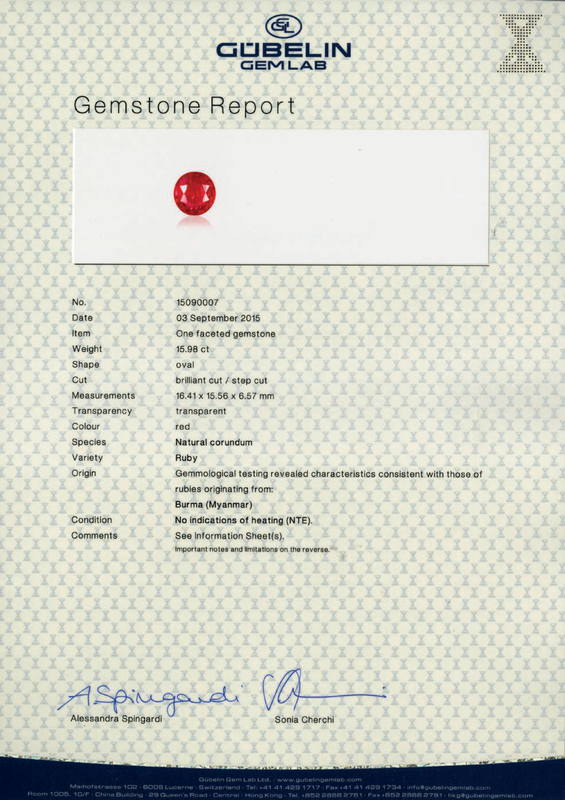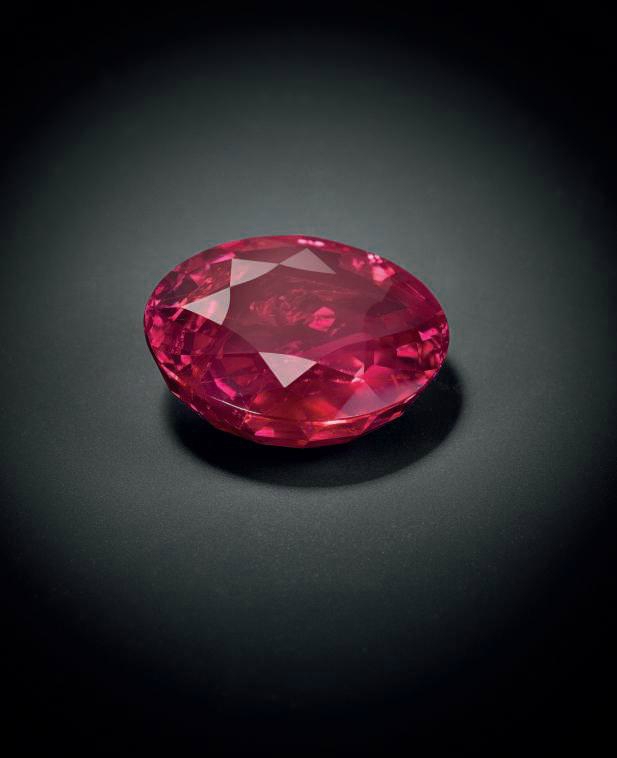The Jubilee Ruby at Christie's New York, 20 april 2016
The Jubilee Ruby, 15.99 carat Burmese ruby and diamond ring by Verdura. Estimate: $12,000,000 – 15,000,000. Photo Christie's Image Ltd 2016
New York – Christie’s is proud to announce its global lineup of spring jewelry sales commencing in New York with the Magnificent Jewels auction on April 20. With over 250 lots the sale features rare diamonds and colored stones as well as exceptional jewels from Buccellati, Cartier, David Webb, Graff, Harry Winston, Van Cleef & Arpels and more. We are especially honored to offer additional jewelery from the collection of Carroll Petrie and other prominent families throughout the United States.
The sale is led by the Jubilee Ruby, which is the most important Burmese ruby to appear at auction in the United States in over 25 years; the last time being when a 16.20 carat gem Burmese ruby sold at Christie’s in October 1990. Featured as an iconic Verdura jewel, the 15.99 carat Jubilee Ruby is a true rarity in its exceptional size, color and quality. The auction also includes some of the rarest diamonds available in today’s market, including an extraordinary Fancy Intense Purple-Pink diamond ring of 10.07 carats (above left) and a perfect D color, Flawless circular cut diamond of 40.43 carats.
Rahul Kadakia, International Head of Jewelry: “Top quality Burmese rubies of over 15 carats are an absolute rarity in the world of colored gemstones and the record price of $18.3 million achieved for the 15.04 carat Crimson Red Ruby at Christie’s Hong Kong in December 2015 exemplified the voracious appetite of collectors for these gems. Fittingly, the Jubilee Ruby comes up for sale in Christie’s 250th Anniversary allowing gem connoisseurs the opportunity to own the very best Burmese ruby offered for sale in the United States in over two and a half decades.“
With estimates from $2,000 to $12,000,000 and a majority of lots offered on behalf of Private Collections and Estates, the Magnificent Jewels sale presents a broad, yet select group of fine gemstones and jewelry that meet the demands of today’s discerning market.
A sensational ruby ring, by Verdura. Estimate: $12,000,000 – 15,000,000. Photo Christie's Image Ltd 2016
Set with an oval-shaped ruby, weighing approximately 15.99 carats, within a circular-cut diamond and polished gold surround, to the trifurcated gold hoop, ring size 7 1/4, mounted in platinum and 18k gold. Signed Verdura.
Accompanied by report no. CS 1074180 dated 11 March 2016 from the AGL American Gemological Laboratories stating that it is the opinion of the Laboratory that the origin of this ruby would be classified as Burma (Myanmar), with no gemological evidence of heat. Also accompanied by a letter stating this Burmese ruby has received the highest and most prestigious TQIR classification of Exceptional
Accompanied by report no. 80019 dated 27 April 2015 from the SSEF Swiss Gemmological Institute stating that the analysed properties confirm the authenticity of this transparent ruby, no indications of heating, origin: Burma (Myanmar); also accompanied by an appendix stating that the ruby possesses extraordinary characteristics and merits special mention and appreciation. The ruby has a remarkable size and weight of 15.991 cts and exhibits an attractive vivid colour, combined with fine purity. The inclusions found by microscopic inspection represent the hallmarks of classical ruby mines in the Mogok valley in Burma (Myanmar), well known for its wealth in gems since historic times. Its attractive vivid red colour is due to a combination of well-balanced trace elements in this gemstone, characteristic for the finest rubies from Mogok. In addition to these qualities, this ruby has been spared exposure to heat treatment and its clarity and colour are thus all natural. A natural ruby from Burma of this size and quality is very rare and thus can be considered an exceptional treasure
With report no. 15090007 dated 3 September 2015 from Gübelin Gem Lab stating that gemmological testing revealed characteristics consistent with those of rubies originating from Burma (Myanmar), no indications of heating
The Jubilee Ruby. Photo Christie's Image Ltd 2016
Notes: To say the Jubilee Ruby is worthy of a king would be no exaggeration. Until the middle of the 19th century, only the Sovereign of Burma or an individual deemed worthy by him would have been allowed the privilege of possessing such a magnificent gemstone.
Although rubies can be found in various countries, it is the legendary mines of Burma which have yielded the most beautiful gems over the centuries. Brought to the attention of the Europeans at the beginning of the fifteenth century, Burmese rubies have not been surpassed in quality by any other mine. Historically they have been mined in the Mogok Valley in the northern part of Burma which is only two miles long and a half a mile wide. One of the main reasons is due to the high chromium content in the ground which accounts for the very specific color, an extremely saturated red often referred to as pigeon’s blood. Another factor is their natural fluorescence which has the effect of making the stone “come alive” and appear internally illuminated.
Whereas emeralds, sapphires, and diamonds regularly appear on the market in important sizes, large rubies of Burmese origin are exceedingly rare. To find an almost circular cut unheated gem weighing more than fifteen carats with near perfect crystallization is the dream of every gemstone connoisseur.
Set in a distinctive gold and diamond mounting by the legendary firm, Verdura, the Jubilee Ruby is the most important ruby of its caliber to be offered for sale at auction in the United States for over twenty five years and Christie’s is proud to present it on our 250th year anniversary.
Bibliography: E. Streeter, Precious stones and gems, 1898

/https%3A%2F%2Fprofilepics.canalblog.com%2Fprofilepics%2F1%2F0%2F100183.jpg)
/https%3A%2F%2Fstorage.canalblog.com%2F03%2F02%2F119589%2F96711876_o.jpg)
/https%3A%2F%2Fstorage.canalblog.com%2F11%2F31%2F119589%2F94773502_o.jpg)
/https%3A%2F%2Fstorage.canalblog.com%2F20%2F83%2F119589%2F94772815_o.jpg)
/https%3A%2F%2Fstorage.canalblog.com%2F26%2F72%2F119589%2F75604929_o.jpg)
/https%3A%2F%2Fstorage.canalblog.com%2F59%2F60%2F119589%2F26458628_o.jpg)
















/http%3A%2F%2Fstorage.canalblog.com%2F97%2F36%2F119589%2F128062654_o.png)
/http%3A%2F%2Fstorage.canalblog.com%2F61%2F54%2F119589%2F127244990_o.jpg)
/http%3A%2F%2Fstorage.canalblog.com%2F97%2F65%2F119589%2F127203047_o.jpg)
/http%3A%2F%2Fstorage.canalblog.com%2F46%2F82%2F119589%2F126463839_o.jpg)